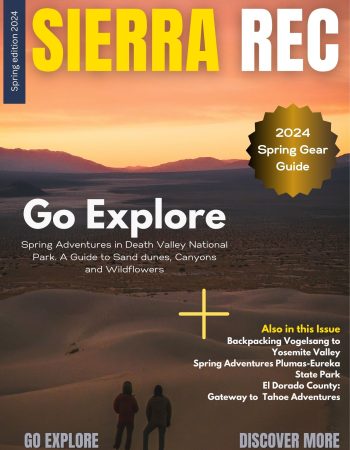Mono Lake Tufa State Natural Reserve is a stunning natural wonder located in eastern California, near the town of Lee Vining. The reserve encompasses a large portion of Mono Lake, a saline soda lake that was formed over 760,000 years ago. Mono Lake is renowned for its unique and otherworldly landscape, which features towering limestone spires called tufa formations that rise out of the lake like ancient sculptures.
The tufa formations were created through a unique geological process that began over 100,000 years ago, when a series of volcanic eruptions in the region created the Mono Basin. Over time, the basin filled with water and dissolved minerals, creating the alkaline lake that exists today. As the lake’s water evaporated, calcium-rich springs on the lakebed caused the formation of the tufa structures.
Mono Lake Tufa State Natural Reserve offers visitors the opportunity to explore this incredible landscape on foot or by canoe or kayak. The reserve features several hiking trails that wind through the tufa formations and provide stunning views of the lake and the surrounding mountains. The reserve is also home to a diverse array of wildlife, including several species of migratory birds, which use the lake as a vital stopover on their annual journeys.
Visitors to Mono Lake Tufa State Natural Reserve can also learn about the history and culture of the region by visiting the nearby Mono Basin Historical Society Museum, which features exhibits on the area’s Native American history, mining history, and natural history. Overall, Mono Lake Tufa State Natural Reserve is a must-see destination for anyone seeking to experience the unique natural beauty and geological wonder of California’s Eastern Sierra region.
The Birds
Mono Lake is a critical habitat for a variety of migratory bird species, which rely on the lake’s rich ecosystem as a stopover point during their annual journeys. Perhaps the most iconic of these species is the California Gull, which uses Mono Lake as a breeding ground and feeds on the lake’s abundant alkali flies and brine shrimp. Other bird species that can be seen at Mono Lake include the Wilson’s Phalarope, the American Avocet, and the Red-necked Phalarope.
One of the most impressive sights at Mono Lake is the annual migration of the Eared Grebe, a small waterbird that travels from as far north as Alaska to winter on the lake’s waters. During peak migration periods, tens of thousands of Eared Grebes can be seen on the lake’s surface, creating a stunning spectacle that attracts birdwatchers from around the world.
In addition to the birds themselves, Mono Lake also supports a thriving ecosystem of insects and other invertebrates, which serve as a vital food source for the lake’s avian inhabitants. The lake’s unique chemistry, which includes high levels of carbonate and dissolved salts, has led to the evolution of several species of brine shrimp and alkali flies that are found nowhere else in the world.
Overall, the migratory birds of Mono Lake play a vital role in the lake’s ecosystem and are a key part of the region’s natural history and cultural heritage. Visitors to Mono Lake Tufa State Natural Reserve can witness these incredible birds and their migrations firsthand, making it a must-see destination for birdwatchers and nature enthusiasts alike.

Native American Heritage
Mono Lake has a rich history of Native American culture and tradition. The Kutzadika’a people, also known as the Mono Lake Paiute, have lived in the area for thousands of years and consider it a sacred place.
The Kutzadika’a people also have a long history of using the lake’s resources for food, medicine, and spiritual practices. They harvested the lake’s brine shrimp and alkali flies, as well as the fish that migrated through the lake’s tributaries. They also used the tufa towers for shelter and ceremonial purposes, and considered the lake to be a portal between the physical world and the spirit world.
Today, visitors to Mono Lake Tufa State Natural Reserve can learn about the Kutzadika’a people and their history through interpretive displays and educational programs offered by the Mono Lake Committee and the local tribal council.
Black sand Beaches, Cinder Cones and Slot Canyons
While Mono Lake is primarily known for its unique tufa towers, it also has some interesting geological features, including black sand beaches and cinder cones that can be hiked.
The black sand beaches at Mono Lake are composed of magnetite, a magnetic mineral that gives the sand its dark color. The magnetite is formed from the breakdown of volcanic rocks in the Mono Basin, and is transported to the lake through streams and rivers. The black sand beaches are particularly prominent at Navy Beach and South Tufa Beach, and offer a striking contrast to the lake’s turquoise waters and white tufa towers.
In addition to the black sand beaches, visitors to Mono Lake can also hike to the top of nearby cinder cones for panoramic views of the lake and surrounding landscape. Cinder cones are formed from explosive volcanic eruptions, which eject large amounts of ash, rock, and lava fragments into the air. As these materials fall back to the ground, they accumulate in a circular shape, forming a cone-shaped hill. Mono Lake has several cinder cones in the surrounding area, including Panum Crater, which can be hiked for a unique perspective on the lake’s geology and history.
Mono lake has a set of hidden fissures on its northern shore. Hikers can discover by hiking the black sand dunes of black point
Can You Fish Mono Lake?
Not exactly. Mono Lake has no fish, or frogs, but is teeming with trillions of brine shrimp and alkali flies, which sustain the millions of migratory birds that visit the lake each year. Freshwater streams feed Mono Lake, supporting lush riparian forests of cottonwood and willow along their banks. Because of the high salinity and alkalinity of Mono Lake, few animals can survive in the water. No fish are able to withstand the conditions of the lake.
However there are several fresh water streams int he watershed that do flow into Mono lake and come form reservoirs near by that are typically great for fishing including: Lundy reservoir, grant Lake, and Parker lake.

The Mono Basin Scenic Area Visitor Center is a great place to start your visit to the Mono Basin. Rangers are on hand to answer questions regarding campgrounds, wilderness permits, the best bird watching locations, bird walks, and other naturalists activities. The center features many resources to help visitors explore the Mono Basin, including interpretive displays on the natural and human history of the area, a bookstore, a 20 minute film on Mono Lake, and two art galleries. The Visitor Center is located just north of Lee Vining, on highway 395, overlooking Mono Lake. Most campgrounds can be reserved by calling 877-444-6777, or visit www.reserveamerica.com.





Leave a Reply